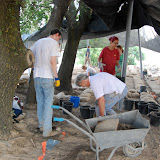 Muhammad’s hijacking of a Messiah from Jews and Christians seems not the only item hijacked by Islam.
Muhammad’s hijacking of a Messiah from Jews and Christians seems not the only item hijacked by Islam.Three years ago, I wrote the book, The Mahdi – Hijacked Messiah, to document Islam’s stealing of a Messiah concept by Muhammad.
Now, my participation on one of Israel’s most interesting archaeological excavations has revealed another major hostage taking by Islam.
Ramat Rachael’s archaeological area, where I’m working this August, takes in the ruins of an interesting church that sits right on the Road of the Patriarchs (now known as Hebron Road). The Kathisma Church is an octagonal structure, built in 456 A.D., which shape is unusual for a church as most are built in the shape of a cross. Sitting square in the center of the church’s octagonal perimeter is an outcropping of solid bedrock some 20 ft. square and several feet high.
The Kathisma Church is where tradition has it that on route to Bethlehem, Mary’s labor pains caused the couple to rest under the shade of a date palm. Joseph is unable to reach the ripe fruit so attractive to Mary, so the tree lowers its fruit to nourish the mother-to-be, and a spring issues forth from under the tree to save their lives in the desert.

Whether one believes the tradition about the church is immaterial. The fact that the tradition predates the Islamic conquest of Jerusalem is the point. The church has a mosaic floor commemorating the story with a date palm flanked by two smaller palms (either symbolizing Joseph and Mary, or the other two crosses on Calvary).
The hijacking of this church’s structure and symbolism is eye-opening. The Dome of the Rock which sits on the Temple Mount is built in the same architectural design, including the bedrock outcropping in the center and an identical date palm mosaic adorns the inside of the dome. As in the church, the date palm is flanked by two other palms. The date of the dome’s construction is 691 A.D., over 200 years later.

The early date of the church and the mosaic are confirmed by Israel’s Antiquities Authority after excavation in 1992. The widening of Hebron Road revealed the church and the dating of the structure brought new and puzzling comparisons to the Islamic structure on the Temple Mount in Jerusalem.
Ron Cantrell














